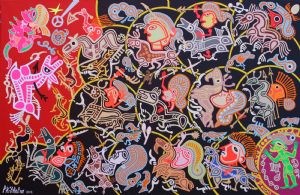| |

|

|
P162 - Bracteates of 12 riders in a furious hunt for the woman ... 2012.
Painting Acrylic
Size: 125 x 190 cm - 49,2 x 74,8 inches
15330 USD
Description:
/ Here we are again in the world of pre-Viking Nordic tribes of the middle fifth of the seventh century straddling the age of migration and that of Vendel. Nothing new under the sun if you have read, failing to have completely memorized the legends of my paintings P153 and P154 which addressed each one bracteate. We are transported into a real wild horde of 12 riders, each from a bracteates, all dating from the period and found in a geographic area that is principally northern Germany, through Denmark, Sweden and Norway. With few exceptions, most were made by different craftsmen, but in a style that I would qualify for both identical and inimitable, if he had not exactly been continuously imitated by other creators unknown us, and this, over a period that did not exceed 150 years! The variety of styles extraordinarily original, forced me to give them a common framework so that there is a semblance of consistency in a table that ends in an uncontrolled inconsistency. Each rider is in flux in a yellow circle that recalls its original circular. And for good reason, since we are witnessing a mad stampede perhaps sponsored by the isolated figure on the far left in his singular bracteate surrounded by runic inscriptions, and this, in a gesture of distress? : Is it his wife or a bride who runs away, and he must bring back dead or alive? Three colors for three different strengths define the unfolding tragedy: red, black and magenta. Elements are present in a woman, thirteen men, five dogs, twelve single birds, three birds included in the caps, an egg in the upper right , a star at the top left and different runic symbols unidentified. Almost in the center of the table the stylized monogram of your artist "runiquement" because as you know already, the monogram of Philhelm was already known at the time when its creator was not of this world! Another nod to the timelessness of this surreal drama and exquisite corpses advertiser? . But as long as the table you want and you still pay attention to the representation of horses and their riders as well as birds that accompany them, (I forgot the dogs!) Search in the rich iconography of wildlife art we all know some more intriguing representation of horse or bird? In my case, I confess that I have not found yet and I thought almost to the completeness of my iconographic archives. This is obviously wonderful for all that remains to be discovered! But the most curious is that even in our imagination we associate with those who created the barbarians, not to say vandals since it is from them that is! Yes the same vandals who sacked Rome in 455 and the proud who in return created these wonderful medals!.
Bracteates: A bracteate (see photo below) from the Latin "bractea" is a thin piece of metal. The imprint, struck by stamping on one side of a very thin metal blank is embossed on the face and hollow on the reverse. The term is used for both currencies for the medals. The pattern is always central, circular, sometimes abstract for our understanding. The bracteate is almost always surrounded by a net cord or a series of zigzag friezes delicately worked. These jewels were manufactured primarily in Northern Europe, especially during the migration period we call the great invasions, or the Germanic Iron Age (in Sweden this includes the Vendel era), but the name is also used to produce parts later, silver produced in central Europe in the early Middle Ages. It also describes parts of the neighboring Huns and the invasion of the Huns in India, in the style of Gupta and Roman coins. Their manufacture did not exceed 150 years between the late fifth century and the middle of the seventh, after the great influx of gold following the bags of Rome, that of 410 by the Visigoths and that of 455 by the Vandals. Their model was undoubtedly provided by the gold medallions that hit the Roman emperors of the fourth century. However the evolution of the figures move away quickly from the Roman model and recomposed according to an aesthetic extremely confusing, perhaps related to Norse mythology, but it seems equally imaginary? Even the runic inscriptions on some medals seem to have no meaning except the magic words? The bracteates are often taken for amulets, some served as penny to Charon, placed in the mouth of death! Regarding currencies bracteates, no runic legend is transcribed or translated in any way the coin legends in Latin, proof that the Norse did not attach any interest within the meaning of these, but only in their material aspect. Despite their appearance monétiforme, the runic bracteates seem absolutely independent of runic coins that appear only four centuries later! And do not forget that the people of Scandinavian origin gave the names of these gods in the days of the week: Tyr was celebrated on Tuesday (in England, Tyre became TYG, who gave birth tuesday.), Odin was celebrated on Wednesday (now Woden or Wotan, who gave birth Wednesday.), Thor was celebrated on Thursday (Thunor gave Thursday.) and to conclude: Freyja was celebrated on Friday where Friday! And why would you not Friday the day of love?
Rune Inscriptions: The use of runes on bracteates is fairly common to write down a text, or more generally a few words. But among all the words or text that you can discover some sequences come recursively: ALU, LAUKAZ, AUJA LATHU Futhark and the full or abbreviated are most frequent. It should also be warned that the runes are read indifferently from left to right (these are generally in line with "normal" reading Latin) or from right to left (reverse direction, which was the normal direction at the beginning) . The use of runes on some medals may seem trivial (a proper name, for example), but very often it can be compared with the use of magic. In this regard, one should keep in mind that in the context of the pagan era (between the fifth and the tenth century), men had a different way of looking at relationships with gods and spirits.
|
|

|
|